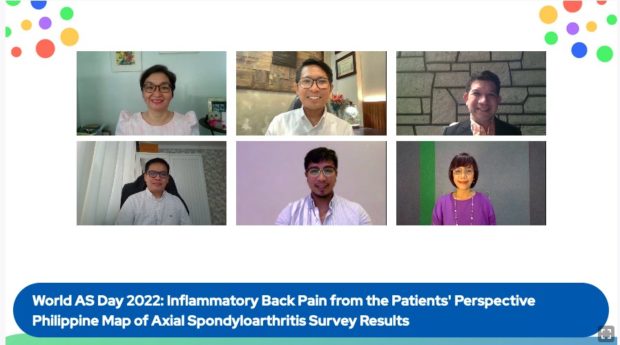On average, Filipinos with axial spondyloarthritis (axSpA) are diagnosed 5.8 years after developing the disease. axSpA has a significant functional, psychosocial and economic impact on patients, highlighting the heavy disease burden of axSpA.
These are among the key findings of the Philippine Map of Axial Spondyloarthritis (PMAS), an online survey conducted by the Philippine Rheumatology Association (PRA) and patient advocacy group Axial Spondyloarthritis Association of the Philippines (ASAPh). PMAS is the first comprehensive survey describing the demographic, disease characteristics, and patterns of disease, diagnosis, and treatment of patients with axSpA in the Philippines. A total of 128 Filipinos living with axSpA participated in the survey from July to October 2021, with the preliminary survey report completed in March 2022.1
AxSpA is a chronic inflammatory disease that primarily affects the spine and sacroiliac joints that connect the spine to the pelvis.2 Symptoms typically manifest as chronic inflammatory back pain, stiffness and fatigue of the pelvis and lower back – although all regions of the body can be affected. AxSpA occurs in approximately 1% of the general population and can affect both men and women, with patients typically being in their twenties when they first develop symptoms.3
Most of the survey respondents were from the National Capital Region (42.2%) and nearby regions (45.4%). Respondents’ age ranged between 18 and 77 years, with an average of 39 years. Majority were male (76.6%) and over half were married (54.7%). Almost half (44.3%) were overweight or obese. Hypertension (35.6%), uveitis or eye inflammation (33.6%), and high cholesterol (28.2%) were the most frequently reported comorbidities.
Delayed diagnosis
Majority (75.8%) were diagnosed by rheumatologists; the rest by orthopedic specialists. Before being diagnosed, most respondents had multiple consultations with a rheumatologist (44.5%), an orthopedic specialist (43.8%), or a general practitioner (27.3%). Delay in axSpA
“Although this still needs validation, a possible explanation for the longer diagnostic delay in women is the misconception that axSpA is a male-specific disease. For women, more common medical conditions are considered before a diagnosis of axSpA is made,” said Dr. Bernadette Heizel M. Reyes, Professor, Division of Rheumatology, Department of Medicine, University of the Philippines-Philippine General Hospital
Only 1 of 5 respondents (19.5%) had a diagnostic delay greater than 10 years, while 34.4% had a diagnostic delay of less than 2 years. Diagnostic delay was shorter in respondents who developed axSpA symptoms more recently; 73.4% were diagnosed between 2011 and 2021.
“The shorter diagnostic delay observed in the PMAS study reflects the improved awareness and access to see a rheumatologist. However, we can still do better by educating and collaborating with primary care physicians and specialists to further shorten the time to diagnosis. In addition, the PMAS study can enhance the patient-physician relationship. Since axSpA is a multidimensional condition, the rheumatologist has the opportunity to discuss important concerns of a patient that are often not addressed on a clinic visit,” said PRA President Dr. Juan Javier Lichauco.
Heavy disease burden
Many respondents had active disease, spinal stiffness, and inflammation in the lumbar and cervical spine and hips. Three in four (75%) complain of moderate to severe stiffness in the lumbar spine. Many reported having difficulty doing routine daily tasks and requiring assistance; physical activity, use of public transportation, and tying shoe laces were the most commonly affected daily activities.
A significant proportion of respondents reported issues related to mental health that affected their productivity. These include sleep problems (28%), anxiety (25.9%) and depression (25%). In addition, the survey results showed a correlation between mental health and disease activity. Respondents also reported that axSpA had a negative impact on their family relationships and social life.
“We hope that the preliminary survey results can help healthcare professionals, policymakers, and pharmaceutical companies better understand the impact of axSpA from the patients’ perspective, and help improve the quality of care, access to treatment, and health outcomes of patients with axSpA,” said ASAPh President Engr. Clark Ferrer.

“The Department of Health lauds the Axial Spondyloarthritis Association of the Philippines and Philippine Rheumatology Association for conducting the Philippine Map of Axial Spondyloarthritis. This groundbreaking and patient-focused survey is in line with the DOH agenda to improve health literacy, quality of care, and appreciation for primary care in the country,” said Dr. Beverly Ho, Concurrent Director IV of the DOH Health Promotion Bureauand Disease Prevention and Control Bureau.
“Congratulations to PRA and ASAPh for completing this important survey and shedding more light on a disease that still remains not well understood around the world. Together with our partners, we want to raise the voice of Filipino patients living with axSpA, help prevent diagnostic delays, and hasten axSpA diagnosis for better treatment outcomes,” said Mr. Jugo Tsumura, Country President & Managing Director, Novartis Healthcare Philippines, Inc.
“Novartis is working with our partners to help address diagnostic delays and shorten the patient journey by adopting a multidisciplinary approach to patient care, and providing patients with inflammatory back pain with tools and health information through the Clarrio app,” said Ms. Christine Fajardo, Patient Engagement Head, Novartis Healthcare Philippines, Inc.
ADVT
Read more Lifestyle stories:
Patrón Tequila celebrates its Mexican heritage with its story of Perfection
Annyeong, K-fans! Pack your bags and get ready to meet your oppas again soon
Healthy, fun, flavorful, chic: Sante and Meraki Restaurants now open at SM MOA